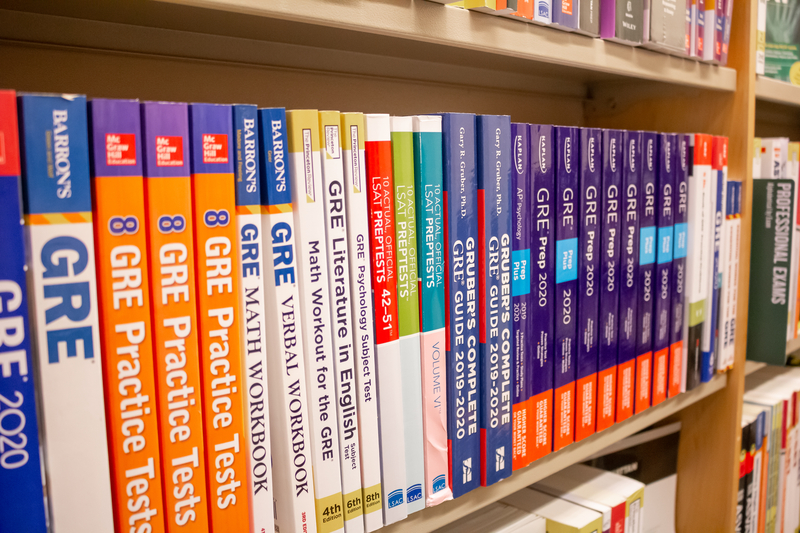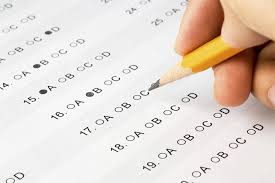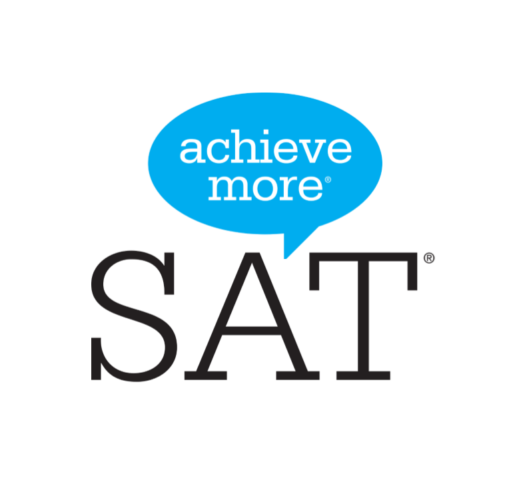GRE vs SAT – What are similarities and differences
Both the GRE and the SAT are exams that test your skills in math, reading, and writing. However, when considering the GRE vs SAT we find noticeable differences that all students should keep in mind when preparing for either one or the other.
Students that have done the SAT and are now thinking of furthering their academic career by taking a GRE should not be misled by the thought that it’s the same exam or simply a harder version of it.
While some things students have learned from their SAT can be translated into preparing the GRE, other aspects may not be at all similar. Being aware of the differences and getting familiar with the exam would definitely help you get the highest possible GRE score.
With that objective in mind, here we will walk you through the similarities and differences between these two very useful and popular tests that may unlock the doors to achieving your academic goals in the future.

The Similarity GRE and SAT
For those students that have already done the SAT and are glad this rite of passage is behind them, we have some news. Accessing a graduate program very often requires preparing for another exam: the GRE. But, what is the GRE like? Is the GRE harder than the SAT?
We are here to answer all your questions about the GRE, the SAT, and how they may be similar or different.
First of all, it’s worth mentioning that the SAT and the GRE are two different and separate exams and the results in the first do not guarantee good results in the second one.
Most people wonder about the GRE difficulty, and a common question it is: is GRE harder than SAT? is the GRE difficult? is the SAT difficult? Well, it’s not easy to say because by the time students take the GRE they have gone through four years of college, taking more complex classes and doing assignments that are more difficult than your standard high school work. All of this prepares students to overcome the challenges the GRE represents.
What is similar in GRE and SAT:
- SAT and the GRE are assessing reading, writing, and math,
- wrong answers are not penalized,
- both almost 100% multiple-choice (except for writing),
- both tests offer several mock exams that students can use to practice,
- analytical writing section expects from you to give opinions
Mainly the fact that both the SAT and the GRE are broad-based tests meant to assess your reading, writing, and math skills. They complement your level of education, so for the SAT, you need to use what you’d normally know at a high school level, while for the GRE, more academic college-level content is required.
In both tests, wrong answers don’t push you backward in terms of scores.
Also, both tests are almost 100% multiple-choice, obviously not considering the writing section where students should write essays following clear academic standards.
When it comes to content, we can see similarities in the type of questions that are there to test your logic, analytic, and reasoning skills. Obviously, for the GRE content, the questions are more complex and sophisticated than for the SAT.
The analytical writing section in both tests expects you to give opinions and justify those using solid arguments. The ability to back up your statements is present in both tests, though the expectations are different in each of them.
Finally, both tests offer several mock exams that students can use to practice while they are preparing to take the SAT or the GRE.
The Difference between GRE vs SAT
We have already established that the GRE and the SAT are different exams, now we are going to discuss their differences in terms of structure, sections, expectations, delivery methods, scores, and costs. Hopefully, a better comprehension of both these exams will help you prepare with more confidence and be able to reach your academic goals with more ease.
Understanding the differences between these two exams will also help you be more successful and prepared, with the ultimate goal of obtaining the maximum possible score. Being aware of these differences will help you to better prepare for the GRE.
What are the differences between the SAT and the GRE?
- GRE is more flexible in terms of when to take it,
- SAT is more stressful (future defining) – limited tries,
- GRE can be done every 21 days up to 5 times in a year,
- writing part is optional in SAT,
- GRE can be done on a computer,
- GRE is much more expensive,
- different test structure,
- completely different scoring system
One of the main differences between the SAT and the GRE is that the latter is much more flexible in terms of when to take it and how many times to do so.
It’s well-known the stress students go through when preparing, booking, and doing their SAT. It’s an important exam that defines their future and it should not be taken lightly. To be able to take the SAT students must book their spot with a lot of anticipation as there are only around seven dates a year the test can be done. There is also a limit regarding how many times the test can be taken if the score is not up to their expectations.
On the other hand, GRE offers a different level of flexibility that many students would probably appreciate. Not only you can book your place just a few days before the exam date, keeping in mind availability, you can also apply for a computer-based test that can be done every 21 days and up to 5 times in a period of 365 days. This means that you can wait until you are feeling ready and prepared to register to do the exam, maximizing your chances of success.
What seems just a bureaucratic difference, may actually have an important impact on how students prepare and, especially, on how they deal with the stress during the time leading towards their exam date.
We will discuss other differences in detail, but it’s worth pointing out that in the SAT the writing part is optional, but… this is not the case in the GRE! Do not skip this part thinking it’s not compulsory, get some practice, and prepare before taking the exam, that way even if the writing part is not your strong suit, you can do it successfully.
While talking about the writing, the GRE includes two essay tasks, one of which is very similar to the SAT writing part. In this section, students have to identify the logical flaws in the text. The other writing task is more challenging, but it is thought in a way that if you do a lot of practice during your college years, you should be fine.

The Purpose of the Test
SAT is required to enter undergraduate studies, the GRE is taken by those applying to a master’s or a doctorate
In terms of purpose, there is a big difference between the GRE and the SAT.
While the SAT is required to enter undergraduate studies, the GRE is taken by those applying to a master’s or a doctorate. This represents a big difference in the type of students taking the test: in the case of the SAT is mostly junior and senior high school students; on the other hand, the GRE is aimed at college students that aspire to be admitted into grad education.
Even if the GRE is the most popular test to access higher education programs, the use of this exam depends on the type of course you are hoping to enter. Most grad programs in science, humanities, and social sciences base their admission on your GRE score. However, other courses, such as law or medicine, will require other types of exams for their admission process.
So, when we are thinking about the SAT vs GRE, we need to keep in mind that they are no equivalent exams and will have very different outcomes.
Some people believe that the GRE is more challenging, but is the GRE difficult? Well, as a test, it sets the minimum standards to do a master’s or doctorate, but with thorough preparation, you should be able to get a good score and consequently strengthen your chances to enter the grad program you’re interested in.
Test Frequency and Availability
We have already briefly mentioned the frequency and availability of both exams as one of those aspects that may impact students and how they prepare for the exam, as well as how stressful the time before the exam date may be.
SAT can only be taken once a month from the beginning of October to December and then in March, May, June, and August.
Since the SAT is a paper-based delivered test, it is not available all year round. The SAT can only be taken once a month from the beginning of October to December and then in March, May, June, and August.
This restrictive availability creates some strain and students usually have to book well in advance their seats to take the exam.
GRE can be taken all through the year in many different locations around the world.
Completely different from the SAT, the GRE can be taken all through the year in many different locations around the world. Being a computer-based test, it is convenient and easy to book, even just a few days before the exam date, subject to availability.
With the GRE, students can take the test 5 times in a year with at least 21 days between one test and the other. The test is available all year round in many different countries.

Computer vs Paper based
Another big difference between the SAT and the GRE is the way these tests are delivered.
Some people have asked what’s better either doing the GRE computer vs paper-based. The truth is that most of the time the GRE is done on the computer. This makes it dynamic and easy to take in different dates and countries, as we mentioned, the GRE is much more flexible as an exam, compared to the SAT.
So there is no real choice for the GRE paper vs computer-based. Most of the time students cannot decide if they prefer paper vs computer GRE, the first option is reserved only for those doing the test in countries where it is not possible to do it on the computer.
The SAT, on the other hand, is done exclusively on paper. At the moment, it is only available as a paper-delivered test, though there have been rumors that in the future it may change and become more technological.
The last thing we should mention is that with the GRE as a computer-based test, the delivery is more adaptive, which means that the second part of the exam will be different depending on how well the student performed on the first part. Therefore, to get the best possible score, students should do their very best at the beginning of the test.

The Cost
Since the purpose of both tests is completely different and their sections and delivery also quite diverse, it’s no surprise that the prices of either the SAT and the GRE are rather opposite. GRE is much more expensive than the SAT.
The price of the SAT is either $46 or $60, depending on students wanting to do the optional writing part or not. The GRE costs significantly more at a rate of $205.
Also, the cost of the score reports is different: the SAT costs $12, while the GRE costs $27 per score recipient.
Test Structure
Even though the SAT and the GRE cover the same general topics: math, reading, and writing; the way these sections are presented is completely different.
The structure of both tests is quite different. In the SAT each section appears only once and always in the same order. It starts with the reading, continues with the writing and language part, which is followed by the math sections (with the part without calculator first and with calculator after), to end always with the essay task if students decide to do it.
As seen from the structure of the SAT, we can say that it’s a very predictable test.
The GRE is presented in a very different way. It does always start with the writing part (the two essay tasks). But afterward, the structure of the exam is completely random. The two verbal sections may be first or may be mixed with the quantitative parts. Even the unscored section will be randomly present in the test (though the research section will always be at the end).
Sections
While both tests assess basically the same skills, the sections in each exam have different names and require different skills to complete successfully.
The SAT has four different parts, including an optional essay that not everyone decides to do. The compulsory sections are reading, writing and language, and math.
There is a particular order in which students have to do the different sections: the first one is reading, followed by writing and language, and then math, and finally the essay (if applicable).
Sometimes we may find that when talking about the SAT people mention 5 sections. This is because the math part can be separated into two: one part can be done using a calculator, and the other part doesn’t allow this. These two sections are scored together, so we can count them as one too.
The sections in the GRE are only three and are called: Verbal Reasoning, Quantitative Reasoning, and Analytical Writing. Each part is divided into several tasks: the Verbal and Quantitative Reasoning are separated into two sections each, while the writing includes two compulsory essays.
For the GRE, there is a fourth section that is an unscored experimental or maybe a research section (it could be maybe an extra Verbal or Quant section; it usually includes 20 questions and it should be done in 35 minutes top).
Students should be aware that the unscored experimental sections are not specified in the test and it may appear in different sections at not specific moment, while the research section will always be by the end of the test and will be mentioned clearly what it is.

Scoring
Another big difference between the SAT and the GRE is the way both tests are scored. They use completely different scales and present their results in their own way.
On the SAT, there is an overall score for both Math sections. The scale, in this case, goes from 200 to 800. On the other hand, the SAT verbal score, meaning the Reading and Writing and Language get also an overall score with another scale that also goes from 200 to 800. Finally, all the scores are combined to produce the total SAT score that goes from 400 to 1600 (in increments of 10 points).
The GRE is scored following a completely different system. There is a common scale from 130 to 170 for the Verbal and Quantitative Section, but the results are usually presented as separate parts and not as a combined result. The GRE math sections are scored similarly.
When talking about the writing part, both tests use different scales and present the results as separated from the rest of the test. But while on the SAT the score goes from 2 to 8 points for each category (there are three parts, writing, analysis, and reading, so the maximum points would be 3 times 8); the GRE uses points from 0 to 6 with half increments to assess the writing part.
As you can see, the scales each of these exams use, and the way they present results is rather different. The way the institutions you are applying to read these results depends on you doing either the SAT or the GRE, and they may have different standards. The most important thing is to remember you cannot translate SAT scores into GRE scores, or do a GRE to SAT conversion.
Get started with the best SAT math tutors today to prepare for your upcoming exam.

Enjoy All The Benefits
You don’t pay your first hour unless you find it a good fit.
Only pay for the time you need.
No subscriptions or upfront payments.
Find Tutors Near You




 What Came Before
What Came Before The United States Constitution (1787) was drafted during the Constitutional Convention in Philadelphia and defined the American government as a constitutional republic. It gives power to its citizens in the preamble by beginning with “We the People” rather than owing itself to the inherited position of a throne (Britain’s constitutional monarchy).
The United States Constitution (1787) was drafted during the Constitutional Convention in Philadelphia and defined the American government as a constitutional republic. It gives power to its citizens in the preamble by beginning with “We the People” rather than owing itself to the inherited position of a throne (Britain’s constitutional monarchy).
 Congressional members are elected by direct popular vote from their constituents (congressional districts elect the House of Reps whereas Statewide elections appoint senators). This system of legislature is a representative democracy where citizens elect members to make laws on their behalf (this is opposed to direct democracy where citizens would vote on matters individually). This is an example of the constitution centralizing power while avoiding tyranny of monarchy.
Congressional members are elected by direct popular vote from their constituents (congressional districts elect the House of Reps whereas Statewide elections appoint senators). This system of legislature is a representative democracy where citizens elect members to make laws on their behalf (this is opposed to direct democracy where citizens would vote on matters individually). This is an example of the constitution centralizing power while avoiding tyranny of monarchy.
 Naturally, your individual learning style and personality will dictate how you you learn best, and what works for one student may not necessarily allow another student to achieve the same success. That’s why we’ve decided to look at several different options to help you decide the best way for you to gain the academic accolades you deserve. After all, if you’re going to be in school or taking those tests, then you may as well get the best results possible!
Naturally, your individual learning style and personality will dictate how you you learn best, and what works for one student may not necessarily allow another student to achieve the same success. That’s why we’ve decided to look at several different options to help you decide the best way for you to gain the academic accolades you deserve. After all, if you’re going to be in school or taking those tests, then you may as well get the best results possible! For many years books have been the ‘go to’ for both teachers and learners. Textbooks provide practice questions, explanations, examples and, quite often, answers. There are also plenty of books that explain theories and provide summaries of major topics, regardless of the subject. Being well-read is beneficial in subjects such as English and history, so the more you read the better your results will be – providing you take in the content that you’ve covered of course! Reading provides you with an extensive vocabulary and a thorough background knowledge on multiple topics. The overall impact that it can have on your studying ability as well as grades is going to be the subject of another post! It’s really a game changer….so start reading more! Books are incredibly accessible, especially if you join the library or various online sites. (And if you don’t want to read, then listen!
For many years books have been the ‘go to’ for both teachers and learners. Textbooks provide practice questions, explanations, examples and, quite often, answers. There are also plenty of books that explain theories and provide summaries of major topics, regardless of the subject. Being well-read is beneficial in subjects such as English and history, so the more you read the better your results will be – providing you take in the content that you’ve covered of course! Reading provides you with an extensive vocabulary and a thorough background knowledge on multiple topics. The overall impact that it can have on your studying ability as well as grades is going to be the subject of another post! It’s really a game changer….so start reading more! Books are incredibly accessible, especially if you join the library or various online sites. (And if you don’t want to read, then listen!
 Tutoring is a great way to solidify your learning or help you come to terms with subjects you are finding difficult. Tutoring is either done one-on-one or in small groups, both having their own set of advantages and disadvantages. You may find some online tutoring services that are excellent, but local tutoring is definitely better for many over online tutors, especially if you need a little extra motivation and help to stay on track.
Tutoring is a great way to solidify your learning or help you come to terms with subjects you are finding difficult. Tutoring is either done one-on-one or in small groups, both having their own set of advantages and disadvantages. You may find some online tutoring services that are excellent, but local tutoring is definitely better for many over online tutors, especially if you need a little extra motivation and help to stay on track.


 As a general rule of thumb, it is suggested to prepare for the LSAT around three or four months prior to test day. This is based on completing around 10-15 hours, perhaps more, of study each week. It is much easier, and much more effective, to study in smaller, more manageable chunks over a longer period of time than it is to try and squeeze 200 hours of study into a couple of weeks!
As a general rule of thumb, it is suggested to prepare for the LSAT around three or four months prior to test day. This is based on completing around 10-15 hours, perhaps more, of study each week. It is much easier, and much more effective, to study in smaller, more manageable chunks over a longer period of time than it is to try and squeeze 200 hours of study into a couple of weeks!
 Once you have established how much time you have each week and have created a preparation schedule, you need to ensure your time is spent effectively. The following tips are actionable and achievable, and will help significantly with your LSAT prep.
Once you have established how much time you have each week and have created a preparation schedule, you need to ensure your time is spent effectively. The following tips are actionable and achievable, and will help significantly with your LSAT prep. Advanced Placement, or AP exams provide an opportunity to show what you know and what you can do. They come at the end of a usually arduous AP course and can be stressful, causing plenty of anxiety. These tests are some of the standardized exams that often help gain college admission and over 3 million students will be taking at least one exam this year! Your best shot at success is to approach exam preparation early, thoroughly and with professional help. Let’s learn more about AP exams, AP tutoring and how you can achieve the best results possible!
Advanced Placement, or AP exams provide an opportunity to show what you know and what you can do. They come at the end of a usually arduous AP course and can be stressful, causing plenty of anxiety. These tests are some of the standardized exams that often help gain college admission and over 3 million students will be taking at least one exam this year! Your best shot at success is to approach exam preparation early, thoroughly and with professional help. Let’s learn more about AP exams, AP tutoring and how you can achieve the best results possible! List of AP Tests by Subject:
List of AP Tests by Subject: AP Tutoring & How to Study for AP Exams
AP Tutoring & How to Study for AP Exams Preparing for AP exams is no small task, in fact, you should start your preparations as early as possible. One to three months ahead of your exams is sufficient time, but this will depend on how busy your usual schedule is and what subjects you are studying, some may require more time than others. Your personal expectations and goals will also play a part in how far in advance you should start your preparations. During this time, your preparation should include the following factors:
Preparing for AP exams is no small task, in fact, you should start your preparations as early as possible. One to three months ahead of your exams is sufficient time, but this will depend on how busy your usual schedule is and what subjects you are studying, some may require more time than others. Your personal expectations and goals will also play a part in how far in advance you should start your preparations. During this time, your preparation should include the following factors: Whether you follow all of these tips, or just a few, you are guaranteed to come out in the top of the class. Don’t delay any further – read on to discover how to study math like a pro!
Whether you follow all of these tips, or just a few, you are guaranteed to come out in the top of the class. Don’t delay any further – read on to discover how to study math like a pro! Read ahead. This means you can have questions for your teacher already prepared. It’s the best way to avoid get caught behind or struggling to understand whatever the topic is. If you know what’s coming you can have your questions and issues ready to go once your teacher has covered the topic. Why wait a day or three before raising your issues?
Read ahead. This means you can have questions for your teacher already prepared. It’s the best way to avoid get caught behind or struggling to understand whatever the topic is. If you know what’s coming you can have your questions and issues ready to go once your teacher has covered the topic. Why wait a day or three before raising your issues? Play math games. By making studying fun you are more likely to do it. Plenty of games can be found online and you can compete against yourself (improving your personal best) or against other players for extra motivation.
Play math games. By making studying fun you are more likely to do it. Plenty of games can be found online and you can compete against yourself (improving your personal best) or against other players for extra motivation. Form a math study group with some like-minded friends is a great answer to the question of ‘how to study math in college’. Studying in a group can be very effective, but also has the potential to turn into a social gathering so make sure your group remains focussed on math.
Form a math study group with some like-minded friends is a great answer to the question of ‘how to study math in college’. Studying in a group can be very effective, but also has the potential to turn into a social gathering so make sure your group remains focussed on math. Ask lots of questions. Don’t be afraid to ask your teacher or tutor loads of questions, and don’t be embarrassed because chances are that many other students will have the same question so you will be helping others too.
Ask lots of questions. Don’t be afraid to ask your teacher or tutor loads of questions, and don’t be embarrassed because chances are that many other students will have the same question so you will be helping others too. Take your time. Sure, exams have time limits and it’s always good to be mindful of this, but if you rush too much you are likely to make silly mistakes. When doing your homework, take the time to ensure you understand each problem.
Take your time. Sure, exams have time limits and it’s always good to be mindful of this, but if you rush too much you are likely to make silly mistakes. When doing your homework, take the time to ensure you understand each problem. There is nothing wrong with wanting perfection, and perfect SAT results are possible for some. With a little time and effort, there is no reason to achieve anything less than your absolute best. Creating effective study habits is no simple task, and time must be spent in order to gain the academic success you deserve, but the good news is that it can be done. There is a plethora of information out there that offers
There is nothing wrong with wanting perfection, and perfect SAT results are possible for some. With a little time and effort, there is no reason to achieve anything less than your absolute best. Creating effective study habits is no simple task, and time must be spent in order to gain the academic success you deserve, but the good news is that it can be done. There is a plethora of information out there that offers  Even if you are a math genius and can expect your exceptional math abilities to carry you to a high SAT total, many colleges will still require a strong reading score. Also, increasing your
Even if you are a math genius and can expect your exceptional math abilities to carry you to a high SAT total, many colleges will still require a strong reading score. Also, increasing your  By
By  The writing section of the SAT can be strenuous and stressful. Time limitations often mean students don’t answer all questions, or make silly mistakes in the ones they do. Alleviating the stress and achieving positive results can be done simultaneously if you follow these simple
The writing section of the SAT can be strenuous and stressful. Time limitations often mean students don’t answer all questions, or make silly mistakes in the ones they do. Alleviating the stress and achieving positive results can be done simultaneously if you follow these simple